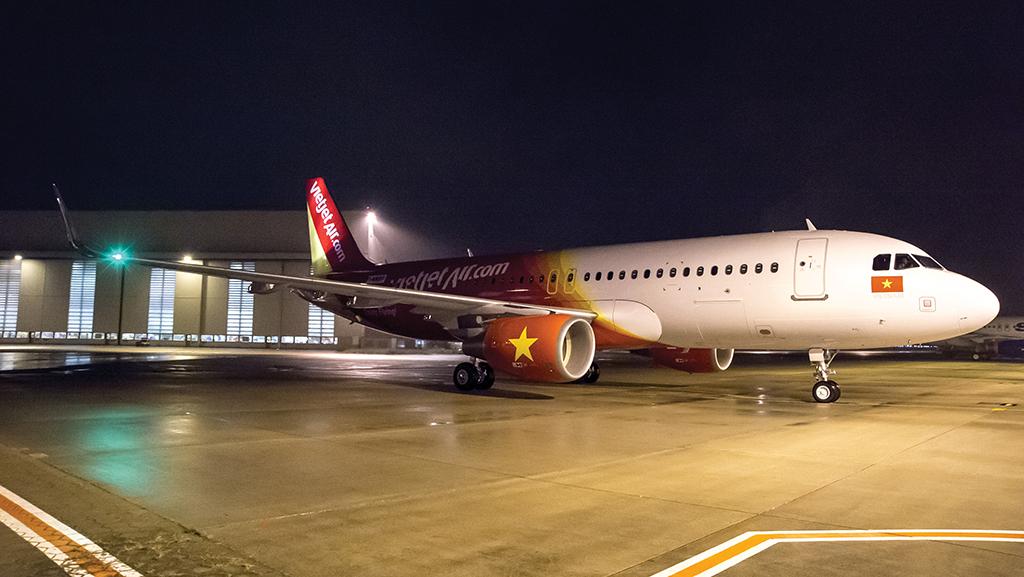
VietJet plans to establish an aircraft maintenance organization to support its rapidly growing fleet.
VietJet Air is among Southeast Asia’s fastest growing airlines. Together with its affiliate Thai VietJet, the group has more than 100 aircraft in service and an additional 260 on order, including roughly 110 Airbus A320neos and over 150 Boeing 737 MAX aircraft. To prepare itself for the impending ramp-up in operations, the low-cost carrier is in the process of establishing its own aircraft maintenance organization.
“VietJet plans to establish an [aircraft maintenance organization] to meet the high demand for maintenance services that a fleet of more than 100 aircraft requires and provide us the flexibility and cost controls that are difficult to achieve when outsourcing,” says VietJet Chief Operating Officer Michael Hickey.
“VietJet’s long-term investment strategy—combined with the support from the local authorities, OEMs and potential partners in the region and globally—is expected to pave the way for the investment and operation of our MRO facility in the coming time,” Hickey adds.
The airline’s maintenance arm, unofficially named VietJet MRO, provides technical services for a range of aircraft up to code F, including those currently registered in Vietnam such as the Boeing 777, 787, Airbus A330 and A350. However, the maintenance branch of the Thai carrier will initially focus on narrowbody aircraft such as the A320, A321, 737 MAX and 737-800 to cater to its own fleet. It will have both FAA and European Union Aviation Safety Agency certification on top of the local Civil Aviation Authority of Vietnam certification.
The airline has several third-party MRO partnerships in the Southeast Asian region to support its operations, including SIA Engineering, Lufthansa Technik, GMF AeroAsia, Asia Aero Technic and ST Engineering Aerospace. Its recent MRO collaborations include a deal with ST Engineering through which the Singaporean company provided maintenance-by-the-hour for VietJet’s entire fleet.
“While we have been happy with the service levels we have experienced, we feel that there is a lack of capacity in this region,” Hickey says. “And that, combined with our aircraft orders and fleet growth plans, is more than sufficient to justify our exciting new plans.”
A significant shift in the carrier’s operations and fleet is the introduction of the A330-300 widebody aircraft, serving new markets such as Australia and Kazakhstan. Vietjet currently has seven A330s.
“From a technical perspective, the plan included: working with the OEMs to review their reliability recommendations; working with previous and existing operators to understand reliability areas that we need to focus on; the renovation and upgrade of our maintenance infrastructure; the establishment of new workshops and hangars; and the improvement of our supply chain,” Hickey says.
VietJet has also opted for Rolls-Royce’s TotalCare service to support the A330’s Trent 700 engines.
The airline has recruited A330 technical experts while simultaneously providing comprehensive training to upskill its existing engineers and mechanics. It has also expanded the capability of its Maintenance Operations Center (MOC) as a central hub to address recurring issues and facilitate quick recovery in case of an AOG situation. Hickey says the revised and improved MOC will play a crucial role in coordinating maintenance activities and ensuring efficient troubleshooting.
As far as technology is concerned, VietJet is further expanding its use of the Swiss-AS AMOS mobile application and introducing electronic tech logs for efficient and streamlined digital maintenance processes. VietJet also plans to establish an AMOS Competence Center to ensure optimal utilization of the system.
VietJet will be hiring a range of personnel to ensure sufficient capacity to its growth, but upskilling current staff is a primary focus to guarantee a stable talent pipeline.
“Upskilling existing staff and providing a pathway into the industry for new entrants will be a priority,” Hickey says. “With such a large operation, we will be focusing on providing high-quality training to many new entrants to the industry that we will employ to ensure we have sufficient skilled staff available as we expand our business.”
